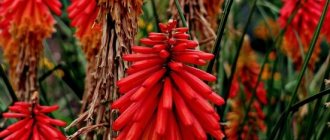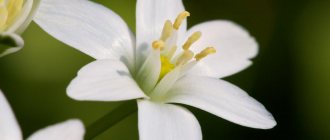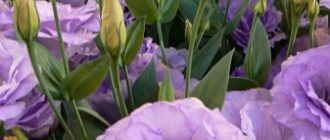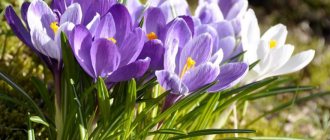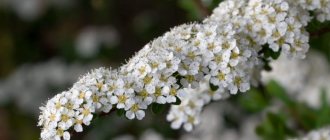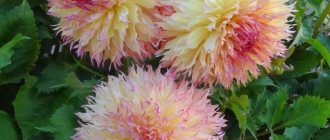1.Description
This perennial shrub has a powerful, branched rhizome, straight, weakly branched shoots and dark green, narrow, pointed leaves.
During the flowering period, fluffy umbrellas are formed on the tops of the shoots - inflorescences up to 25 cm in diameter. The flowers are small, with numerous stamens, fluffy, and come in white, pink, lilac or violet.
Faded inflorescences become silvery-white; after flowering, fruits are formed - achenes with a single seed.
Pokonnik is an excellent honey plant with a sweetish aroma.
Height . The height of the plant depends on the specific species and can vary from 1.5 to 2.5 m.
↑ Up,
Difficulties in growing saplings
- If you plan to buy seedlings, then you must pay attention to the fact that the entire root system must be in the pot, but in no case outside it, since such a seedling will not grow into a strong and healthy plant. This is considered a gross violation in growing seedlings; such seedlings bloom poorly and are susceptible to insect attacks and infections.
- The sapling has a long germination time. Therefore, seeds can germinate until the beginning of May, and this phenomenon is considered completely normal and acceptable.
- If you choose the wrong place to plant the window sill, then due to lack of sunlight the flowers will be small and there will be very few corollas. The flowering period may also be significantly reduced.
3.Planting and care in open ground
When growing in the garden, humid places located near small bodies of water are suitable for sills.
↑ Up,
3.1.How and when to plant
Planting in open ground is carried out using seedlings. First, the area is loosened, stones and weeds are removed, fertilizer is added for flowering plants, then planting holes are made. Between planting holes, such a distance is left so that a gap of 60 - 70 cm is maintained between plants.
A day before planting, the seedlings are watered abundantly to soften the root ball, then, keeping the earthen ball, they are planted in planting holes, covered with earth, which is then lightly compacted to remove air pockets. Flowers planted in the garden are watered abundantly with warm water.
↑ Up,
3.2.How to care for the window sill in the garden
The plant can be in the same place for more than 5 years and will only gain attractiveness. Mature bushes more than 5 years old will require replanting. When grown in the garden, the sapling loves abundant watering and loose soil, which easily allows water and air to pass through to the root system. In order to retard the growth of weeds, the bases of plants are mulched with peat, sawdust or hay.
For abundant and long-lasting flowering, plants will need feeding throughout the season. 1 is carried out in the spring, with the formation of the first leaves, and the second is done before the formation of the first buds in the summer.
↑ Up,
3.3. Shelter for the winter
When grown in the conditions of the Middle Zone, the sapling will not require shelter for the winter and will tolerate it quite easily. The first young shoots will appear on these plants quite late, in May.
↑ Up,
Caring for the sill on the site
This plant needs plenty of moisture. Water it regularly and often throughout the season, especially on hot summer days. Feeding with liquid mineral complexes will also have a positive effect on plant development. They are usually carried out in the second half of June and when the saplings lay buds.
Advice. Sometimes the plant is fed with an additional portion in March.
The sapling grows in one place for at least 5 years, or even 10. An adult specimen is not easy to transplant, because its root branches and grows strongly. Evpatorium takes root well and takes root. However, at the same time, it conflicts little with other ornamental crops and is not inclined to grow on the site.
The window sill is not the best place for insect pests and fungal viruses to live. The plant is considered poisonous, so it copes with ailments and insects on its own. But sometimes greenery is affected by leaf miners. In this case, remove and destroy the affected foliage.
The window sill does not attract pests
To overwinter the Eupatorium, you need to prune it. Carry out the work at the end of flowering. Trim the flower stalks, leaving stumps no higher than 10–15 cm. The plant does not require protection from frost, since it can overwinter without shelter. The exception is young specimens.
6.Use in landscape design
Gardeners love to use this beautiful, tall plant in landscape compositions; it looks good in the background, near fences and near ponds. Often the window sill grows as a compact bush and does not require support.
A distinctive feature of the plant is that it does not suppress other flowers. When grown in the garden, the sapling successfully develops both in a well-lit area and in partial shade.
↑ Up,
Pests and diseases
The sapling has good immunity and is quite rarely affected by both diseases and pests. Occasionally, plantings can be damaged by leaf miners, which are difficult to remove even with the help of an effective insecticide. Such bushes must be pruned, removing all areas affected by miners, and the remaining part must be processed. If the procedure works, the plant will quickly recover.
To prevent any diseases, it is important to follow all the rules of agricultural planting technology.
7. Reproduction
7.1.Growing from seeds
Saplings are propagated by seeds, which are sown in March for seedlings. For seedlings, take flower pots, arrange drainage in the form of expanded clay, broken bricks or clay shards and fill them with loose, nutritious flower soil.
The soil is watered abundantly, and the seeds are sown, covering them with a layer of soil 7-10 mm thick. To create a greenhouse effect and maintain high air humidity, the seedlings are covered with a transparent film on top and left in a warm, illuminated place.
↑ Up,
2 - 3 weeks after sowing, the first shoots appear, at which time the cover can be completely removed.
Plants are planted in separate containers if sowing was carried out in seedling boxes. The best time for picketing is the period when each bush can boast of real 4 leaf blades.
↑ Up,
The first buds will appear on plants grown from seeds after 3 years.
Seed propagation is quite easy and when grown in open ground under mature bushes, you can even find self-seeding young plants.
↑ Up,
7.2.Cuttings
The sapling can be propagated vegetatively or by cuttings. At the beginning of summer, half-ripe stem cuttings are separated from the main plants with a sharp, sterilized garden tool - pruning shears or a knife. Each cutting should have 3 leaf nodes.
The bases of the cuttings are powdered with powders containing plant growth hormones and immersed in loose soil consisting of peat and river sand, 1 cm deep at a slight angle.
↑ Up,
Within a month, signs of new growth can be seen at the base of the cuttings - this will indicate that the first roots have appeared under the surface of the soil. In August, such plants can be transplanted into open ground.
↑ Up,
7.3 Division
Adult specimens can be propagated by division during transplantation. To carry out the procedure, plants are dug up and the root system is shaken off the ground.
They mark the location of the division, making sure that each division receives its own root system and a well-developed above-ground part.
Dividing an adult sapling is not an easy task, since the bases of the stems become thick and woody with age, which means you may even have to use an ax or saw.
↑ Up,
Landscape use of window sill
This crop is grown both as an independent decoration and in composition with other plants. In the second case, even at the stage of choosing a place for planting, calculate everything so that the window sill acts as a background for smaller flowers. The plant becomes more beautiful with age. Combinations of varieties of different heights look good in the garden.
Attention! The sapling is one of the last to finish flowering in the garden. Gardeners use this feature for decorative combination with large grains.
Group planting is used to hide a fence, fence or unsightly wall. This method will visually expand the space of the site. The aroma of flowering saplings is similar to a spicy smell and attracts butterflies. In winter, tall varieties covered with snow or frost will also decorate the garden. When cut, the window sill retains its appearance in a vase of water for quite a long time. Suitable for Ekiban.
The window sill camouflages hedges and outbuildings well
9.Healing properties
In folk medicine, all parts of the plant are used - leaves, roots and inflorescences. Sapwood is used as an anti-inflammatory, diaphoretic, expectorant, analgesic, wound-healing, and laxative.
Various ointments, tinctures and decoctions are prepared based on the extracts of this shrub.
↑ Up,
There are also some contraindications when using sapwood for medical purposes. Since all parts of the plant are poisonous, extreme caution must be taken and taken under the supervision of doctors. It is prohibited to give plant-based products to children under 18 years of age.
↑ Up,
How to choose the right window sill when purchasing
To purchase a window sill, a specialized garden store is best suited; this will provide a certain guarantee of the quality of the planting material.
Rules for choosing sapling rhizomes
The product being sold must be in transparent packaging so that it is possible to evaluate its quality according to the following criteria:
- There is no mold or rot on the rhizome.
- The roots are intact, without mechanical damage.
- The rhizome is hard, elastic, and at the same time unbreakable.
- When purchased in spring, swollen buds are visible.
10.Varieties and types of window sill:
10.1. Purple sapling - Eupatorium purpureum
Purple sapling is a fairly popular species in floriculture; it is a perennial shrub up to 2 m high. The plant grows quickly, forming entire colonies. The main decoration of bushes of this type are flowers that do not fall off for a long time and are pleasing to the eye.
The inflorescences reach a diameter of 30 cm. The rhizome is well developed. The leaves are green with purple veins. In its natural environment it prefers to grow along river banks and in meadows.
↑ Up,
10.2.Spotted sapling - Eupatorium maculatum
This North American representative of the genus got its name from the spots on the stem of different colors. The plants reach a height of 2 m; they prefer to settle in damp places. During the flowering period, purple or pink flowers are formed. The leaves are elongated, collected in whorls - four leaf blades are attached in a circle to one leaf node.
↑ Up,
10.2.1.Spotted Riesenschirm - Eupatorium maculatum Riesenschirm
A flowering perennial up to 150 cm high with delicate pink buds at the top of erect, strong shoots. The flowering period begins in the second half of summer and lasts until October. After flowering, fluffy white seeds form in place of the buds.
↑ Up,
10.3. Wrinkled sable - Eupatorium rugosa
Perennial plants up to 150 cm high, with increased frost resistance. The leaves of this variety are oval in shape, framed by small teeth with a purple tint. The corymbose inflorescences reach a diameter of 15 cm and consist of many small white flowers. The flowering period begins late - at the end of August. When grown in open ground, it requires support. This shrub is quite moisture-loving.
↑ Up,
10.4. Hemp sapling - Eupatorium cannabinus
Hemp sapling got its name for its external resemblance to hemp leaves. Plants of this species form powerful rhizomes and erect shoots up to one and a half meters high. The flowers are light pink, collected in corymbose inflorescences. In its natural habitat it prefers important and even slightly marshy spaces.
Caring for the sill in the garden
Posonnik is a moisture-loving plant. It needs abundant and regular watering during the period of active growth, after the plant begins to gain color, watering should be reduced slightly. The soil should not dry out, but you should not allow it to become waterlogged or stagnant; the window sill does not like this, so excessive moisture can lead to rotting of the root system or the death of the entire plant.
After each watering, you should carefully loosen the soil so as not to damage the root system; this will help saturate the roots of the plant with oxygen and fight growing weeds much less often.
Remove weeds as needed, in order to reduce the need for weeding after planting, you need to mulch the soil around the plant with peat, sawdust, dry leaves, hay or straw.
Fertilizers and fertilizers
Fertilizing must be done at least three times per season. Compost solution, chicken manure solution and rotted manure can be used as organic fertilizers. Balanced complexes of mineral fertilizers, which are designed specifically for flowering garden plants, are also perfect. All fertilizers must be applied exclusively in liquid form and carefully at the root, so as not to get on the stems, leaves, and especially flowers.
After the flowering period ends, the inflorescences and leaves wither, it is necessary to prune the dry leaves and inflorescences. Before preparing the plant for wintering, you need to carefully cut off the stems of the Eupatorium almost completely, leaving at least ten centimeters of the stem at the root.
Preparing for winter
After completely trimming the stems, it is necessary to cover the area where the sill roots remain with dry leaves, peat or hay. This will allow the plant to survive the winter well and delight with its flowering next year. Less cold-resistant varieties also need to be covered with some special covering material, which will make it easier to withstand winter frosts.
Subtleties of care
Plants should be cut back to the ground at the end of flowering in the fall and divided every three years to allow the bushes to renew themselves. In general, growing such a flower is not difficult, it does not require careful care and is one of the most picky.
For maintenance, you will need to regularly loosen the soil around and mulch it.
The immersion depth of the loosening tool should not be large, otherwise the roots can be easily damaged. As for watering, the bushes love moisture very much; in their natural environment they try to grow where there is enough of it, so watering should be done on a regular basis. The plant will tolerate short periods of drought just fine, but it is better to avoid this. With well-prepared soil there is no reason to be afraid of waterlogging.
As the main feeding, you can use a mineral complex, for example, “Zdraven” or nitroammofoska . After planting, they are introduced into the soil at the end of June or during the formation of inflorescences, and then in the spring.
This shrub is not susceptible to pests or diseases, but this requires the gardener to choose the right propagation material.
The biggest problem a person can face is miners. These insects are very fond of foliage because it has thin skin. If affected, nothing will help; any treatment is useless. You only have to remove the affected parts or entire bushes .
